These are the episode notes and errata for Pratchat episode 67, “The Three-Elf Problem“, discussing Martin Wallace’s 2013 Discworld board game, The Witches, with returning guest Steve Lamattina.
Iconographic Evidence
As promised, here are some photos of the game.
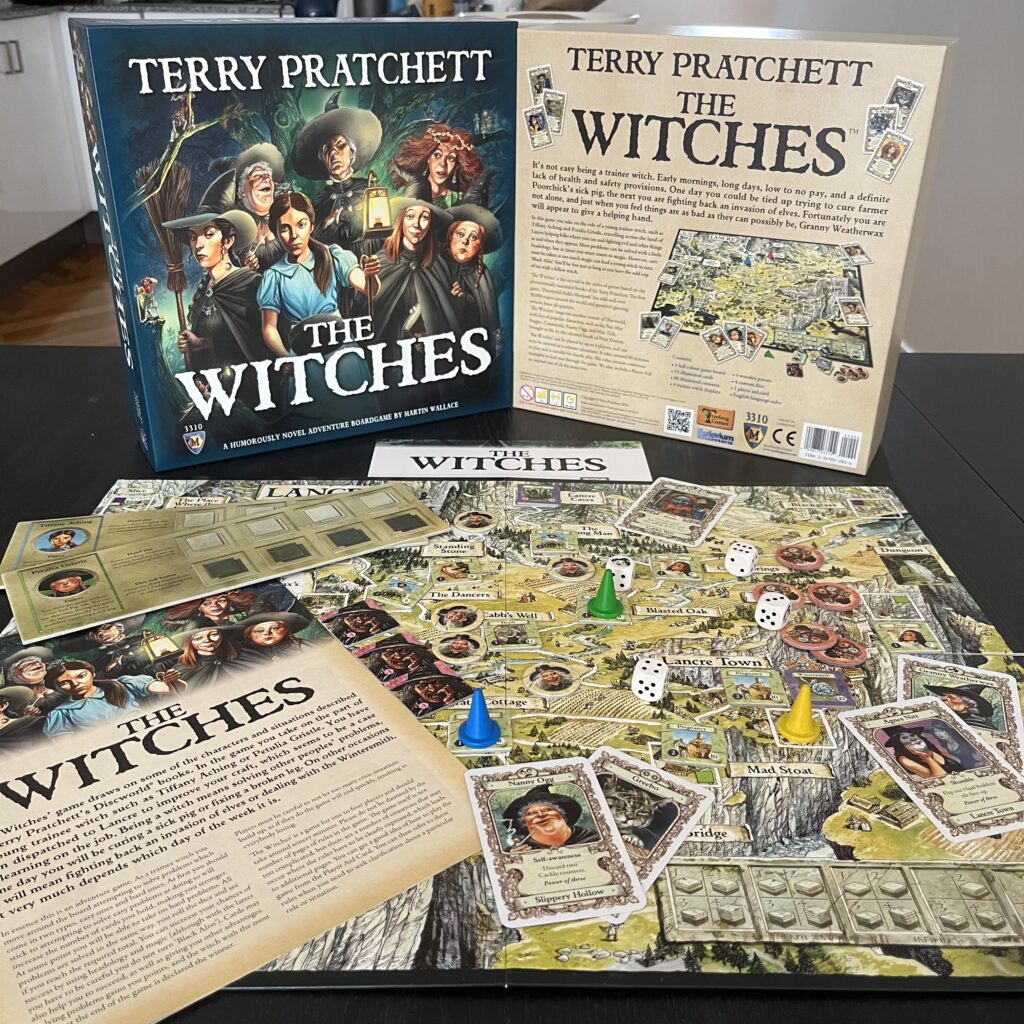
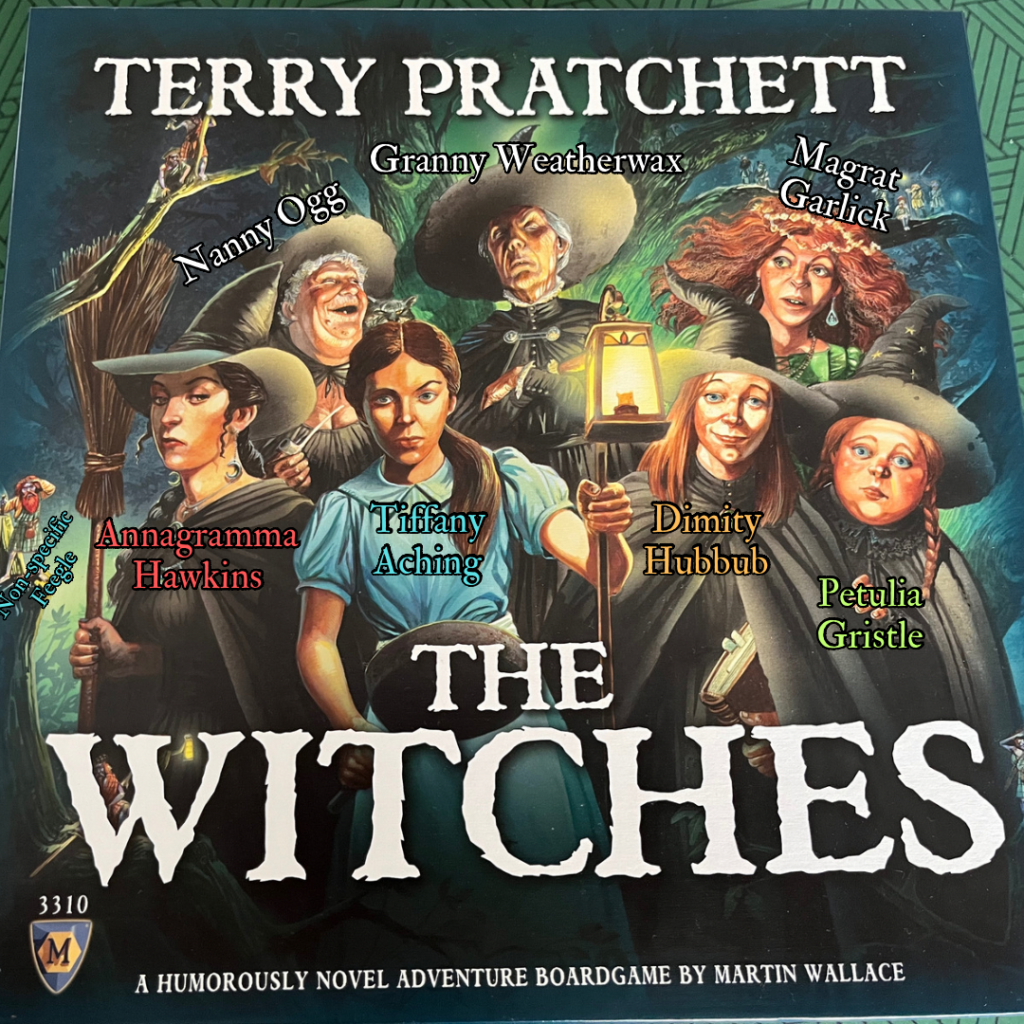
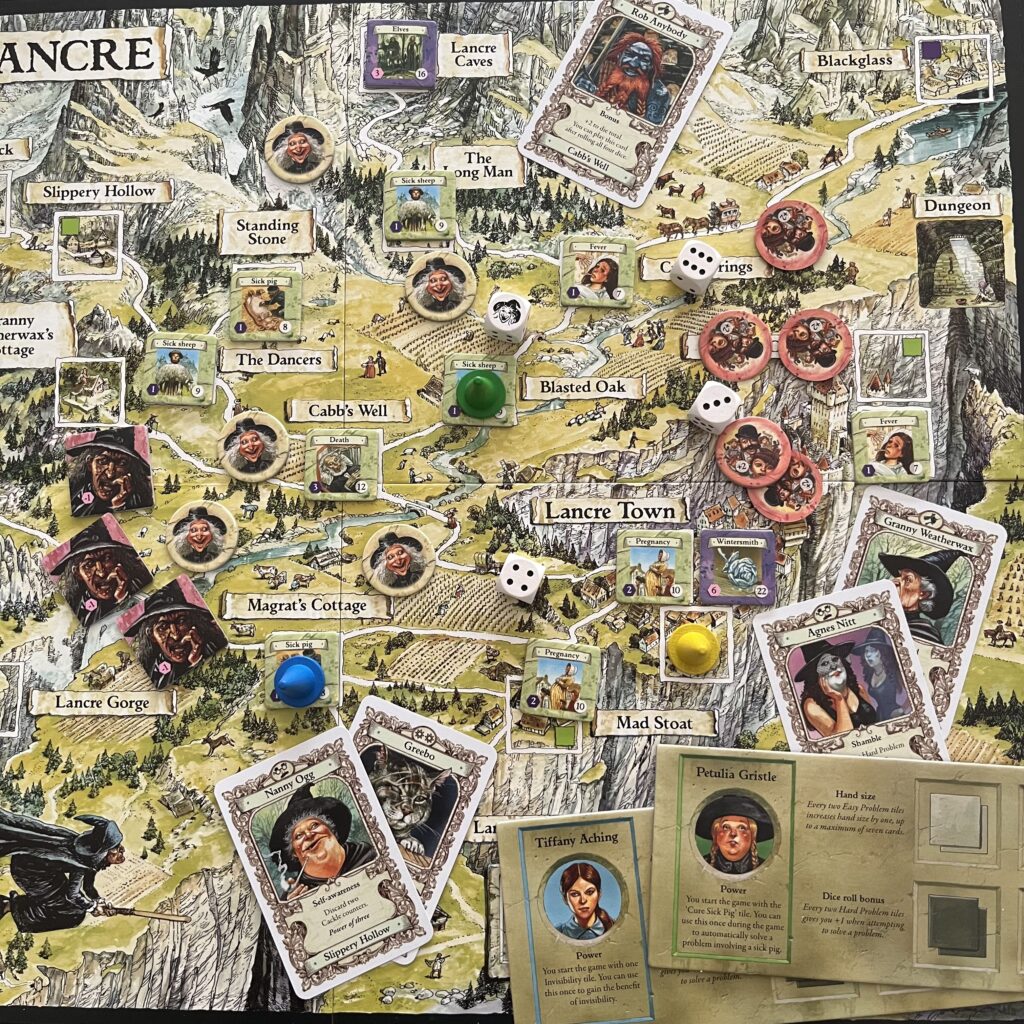
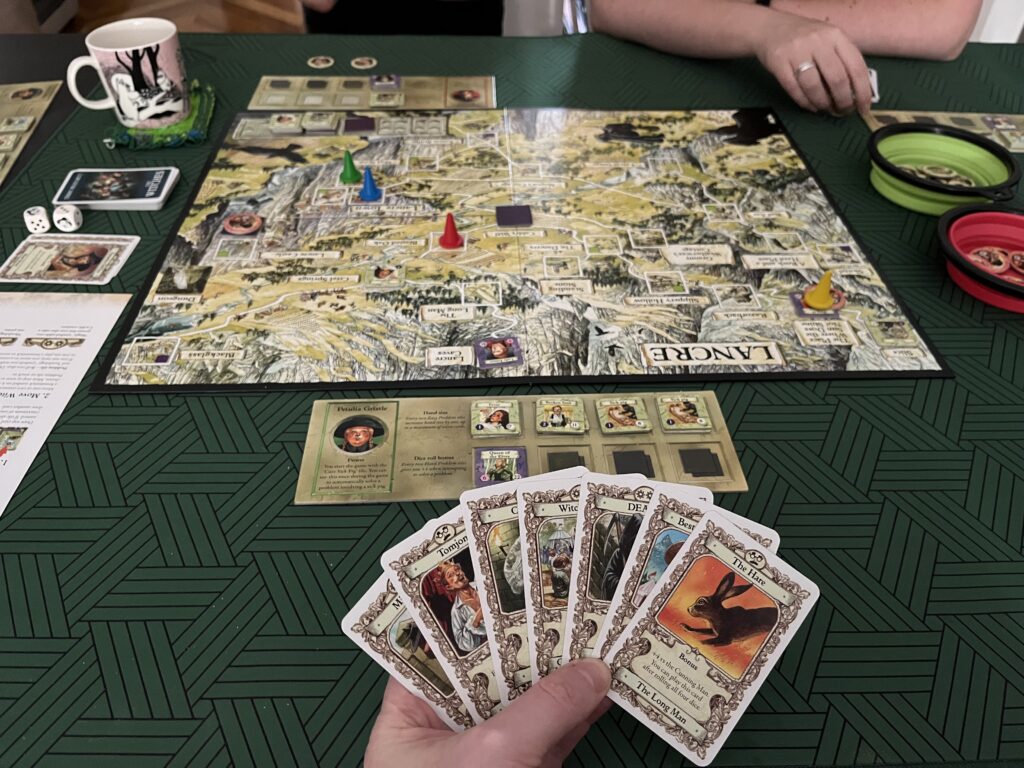
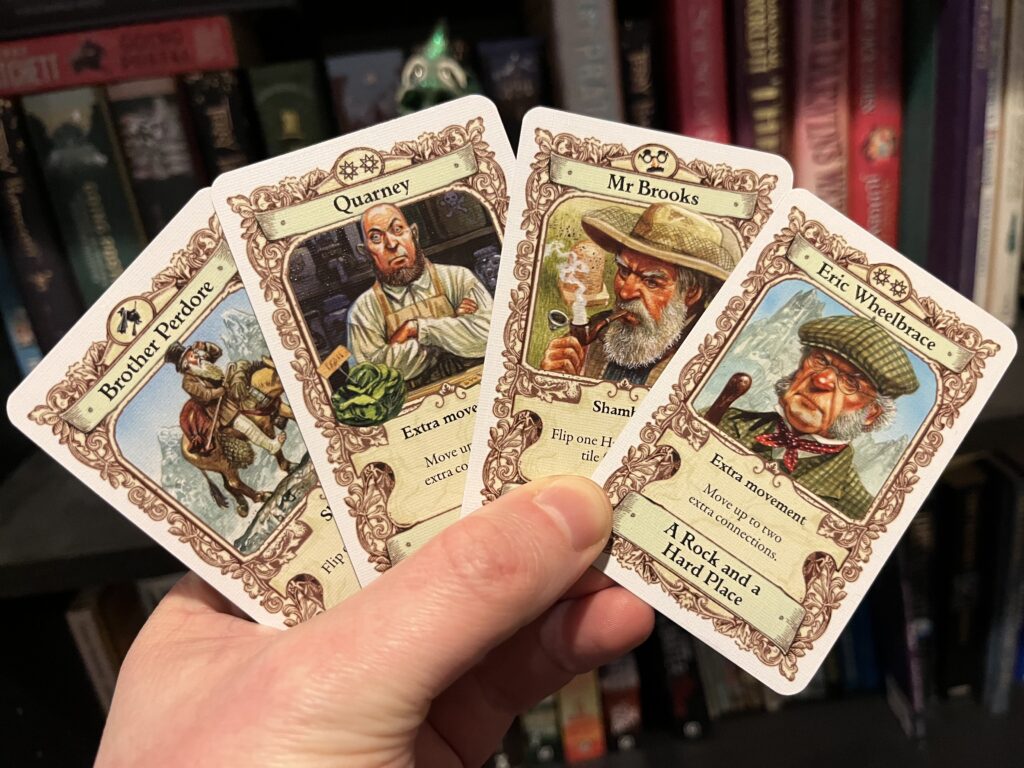
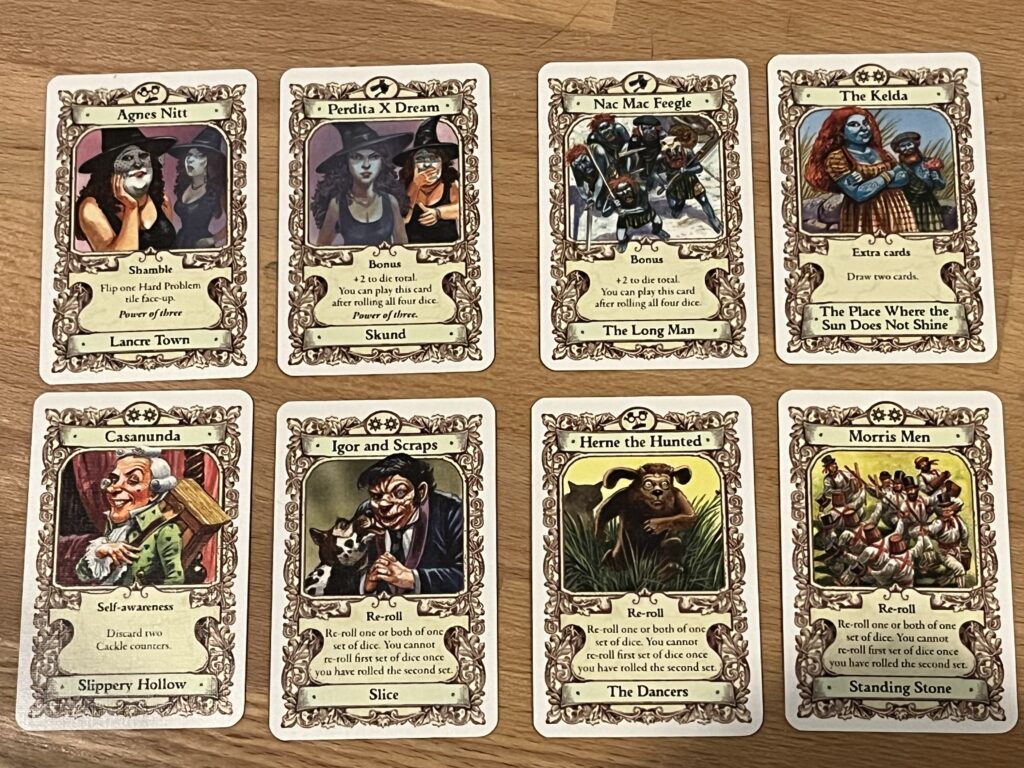
Notes and Errata
- The episode title takes inspiration from the 2008 science fiction novel The Three-Body Problem by Chinese author Liu Cixin. The novel in turn takes it’s title from the three-body problem of physics, which refers to the difficulty of calculating the relative motion of three bodies whose masses will interact thanks to gravitational force. In the game, three elves are a problem because they cause everyone to immediately lose.
- Steve last appeared on Pratchat for Pratchat28, “All Our Base Are Belong to You”, discussing Only You Can Save Mankind, back in February 2020 – the second-last time we recorded regularly in person.
- The last in-person episode was #Pratchat29, “Great Rimward Land”, with Fury. We moved to remote recording from episode 30 (“Looking Widdershins”), though Ben did record in person for “The Troll’s Gambit” with Melissa Rogerson, in November 2022.
- Dimity Hubbub is not actually known for being talkative, but rather being clumsy; in her first appearance she has set fire to her own hat, and steps on a piece of Annagramma’s occult jewellery. Dimity appears in A Hat Full of Sky (where she appears in two scenes), Wintersmith (in which she gets a whole two lines of dialogue) and The Shepherd’s Crown (again, only very briefly).
- Tiffany’s time in Lancre is covered in A Hat Full of Sky (#Pratchat43, “Big Wee Hag: Far Fra’ Home”) and Wintersmith (#Pratchat51, “Boffoing the Winter Slayer“).
- Lancre Gorge features fairly prominently in Wyrd Sisters, and is where Lord Felmet eventually ends up. In Lords and Ladies, its described like this: “Lancre is cut off from the rest of the lands of mankind by a bridge over Lancre Gorge, above the shallow but poisonously fast and treacherous Lancre River.” (A footnote admits that “Lancrastians did not consider geography to be a very original science.”)
- Garth Nix, who was our guest for #Pratchat51 a bit over a year ago, is an Australian science fiction and fantasy author best known for his Old Kingdom series of young adult fantasy novels. In the books, the “Old Kingdom” is a place of sorcery and monsters, separated from its neighbour Ancelstierre by a wall which keeps the magic out. The first book is 1995’s Sabriel, while the latest is the prequel Terciel and Elinor, published in late 2021.
- The various editions of The Witches (which is called The Witches: A Discworld Game on BoardGameGeek) include:
- The Treefrog Games’ Collector’s Edition, published in an edition of 2,000 copies, featuring the pewter miniatures and a cloth bag to keep them in, an A1 poster of artwork from the game, different artwork on the box cover, a different shaped box, and a larger map. (We presume this just means physically larger, not that there are any additional locations.) While you can’t buyt the minatures separately, you did used to be able to buy a set of coloured plastic miniatures for the game from Micro Art Studio in Poland, who still produce a line of Discworld miniatures – though the young witches are no longer available.
- The Mayfair Games Standard Edition, the one we played. It has wooden witch’s hat pieces for the players.
- The game has also been published in several other languages: German, Polish, Russian, Bulgarian, Czech and Spanish. These all appear to use the same art, with only the text translated.
- Mayfair Games was
- Martin Wallace is an English game designer who now lives in Australia. After getting his start in wargames in the 1990s, he became a very well-known game designer. His games include the heavy train games Brass: Lancashire (originally just Brass) and it’s successor Brass: Birmingham; two quite different editions of A Study in Emerald, a Sherlock Holmes/H.P. Lovecraft mash-up based on the short story by Neil Gaiman; and most recently the fantasy war game Bloodstones. (Ben is mistaken, however, about Once Upon a Time and The Extraordinary Adventures of Baron Munchausen, which were designed by the entirely different (if similarly named) James Wallis. Sorry James!) Martin’s company Treefrog Games was active until 2016, when he closed it down to focus on working as a designer. Bloodstones was his first new venture in self-publishing since then, this time under the name “Wallace Designs”.
- The very brief Martin Wallace interview about The Witches can be found in the BoardGameGeek forums for The Witches. Read the interview here.
- When Nanny visits the Long Man in Lords and Ladies, she takes Casanunda along with her. His mind is boggled both by the Long Man, and the resemblance of the King of the Elves within to “his picture”.
- The Felmets appear in Wyrd Sisters (#Pratchat4, “Enter Three Wytches”), and they do indeed both die by the end of the book. Lord Felmet plunges to his death in Lancre Gorge, while Lady Felmet is cast into the woods, where the woodland creatures, acting as the soul of the country itself, er…take care of her.
- Ben hasn’t been able to think of any other games that split a dice roll in half, though there are many that use a “push-your-luck” mechanic. This is usually achieved by allowing a player to re-roll one or more of their dice with an escalating level of risk and reward.
- Melbourne’s public transport network, created by the “Octopus Act” in the late eighteenth century, has a large number of train and tram lines radiating out from the Central Business District. While there used to be two “circle lines” that connected stations on these lines to each other, nowadays to change from one to the other you generally have to travel into the city and back out again. Only buses travel in alternate directions, but they are generally less frequent and less reliable, thanks to traffic.
- Agnes Nitt and Perdita X Dream appear briefly in Lords and Ladies, but are best known from Maskerade (#Pratchat23, “The Music of the Nitt“) and Carpe Jugulum (#Pratchat36, “Home Alone, But Vampires”).
- Ben’s favourite board game Pandemic was designed by Matt Leacock and first published in 2008. It’s a fully co-operative game (see below) in which players are members of the Centre for Disease Control, trying to keep four global pandemics in check while they find cures for them all. The current edition of the game is published by Z-Man Games.
- Fully cooperative games are ones in which players do not compete, but instead win or lose (and sometimes score) together. Board game examples include Pandemic, Flash Point: Fire Rescue and Spirit Island. Semi-cooperative games feature some cooperation, but the players also compete against each other in some way. In Ben’s experience, most such games feature strong player cooperation, usual through a high chance of everyone losing, but add in secret personal goals that might put them into conflict. This is a feature of “hidden traitor” and social deduction games like Battlestar Galactica and Dead of Winter, though these might also be considered team games. The Witches is different in that the competitive side of the game dominates; the cooperative element is relatively light, with the threat of losing fairly slight.
- Solo board games are very popular in the “print and play” scene – cheap games you can download and print on paper yourself. They include Bargain Basement Bathysphere (since published as a boxed game), Utopia Engine and RATS: High Tea at Sea. Nemo’s War is at the other end of the scale: it’s a large game with a big board, hundreds of components and several expansions. Other boxed solo games include Under Falling Skies (which started life as a print and play game), Final Girl, Coffee Roaster and Deep Space D-6.
- We discussed Good Omens back in #Pratchat15, “It’s the End of the World as We Know It (And I Feel Nice and Accurate)”.
- The Discworld Emporium is the most famous officially licensed producer of Discworld merchandise which grew out of Clarecraft, a fantasy figurine business run by Isobel and Bernard Pearson, who started doing Discworld miniatures in the early 1990s. We most recently talked about them in #Pratchat53, “A (Very) Few Words by Hner Ner Hner”. They are credited as the author of many of the more recent spin-off books, like The Compleat Ankh-Morpork and The Nac Mac Feegle Big Wee Alphabet Book, so you’ll no doubt here some more about them before we’re done.
- The fans whose likenesses were used for the box art witches were Kate Oldroyd (Tiffany Aching), Victoria Lear (Petulia Gristle) and Pam Gower (Granny Weatherwax). As we mentioned, Pam sadly passed away in January 2023. She wasn’t just the inspiration for this box art, but also Paul Kidby’s bust of Granny Weatherwax. You can read Bernard Pearson’s thoughts about Pam in his Cunning Artificer blog in 2015, including an anecdote about her meeting with Terry which also appears in the biography.
- Rowlf the Dog was one of the original muppet characters, originally performed by Jim Henson. He notably achieved solo fame in the early 1960s as a regular on the Jimmy Dean Show, before becoming the piano player in The Muppet Show and subsequent movies. His big number in The Muppet Movie is a duet with Kermit, “I Hope That Somethin’ Better Comes Along”.
- Wilfred is the title character of a short film and two television series, all created by Australian comic actors Adam Zwar and Jason Gann, and starring Gann (in a costume) as “Wilfred”, an anthropomorphic dog, who is suspicious and jealous of his owner’s new partner. The original short won awards at Tropfest, Australia’s biggest short film festival, in 2007, and became a series on SBS which ran for two seasons in 2010. It was then adapted for the US market, starring Gann as Wilfred and Elijah Wood as Ryan, a depressed man who befriends Wilfred when his neighbour asks him to look after the dog. In this version the question of whether Wilfred can truly speak, or even really exists, is much more present. The American Wilfred ran for four seasons on FX between 2011 and 2014. There was also a Russian adaptation, retitled Charlie.
- The board games we recommended are:
- Wingspan
- Dominion
- Castles of Mad King Ludwig
- The Palace of Mad King Ludwig
- Pandemic
- Pandemic: Fall of Rome (now called Fall of Rome: A Pandemic System Game)
- Thunderbirds
Thanks for reading our notes! If we missed anything, or you have questions, please let us know.
